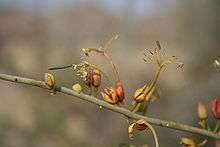Cadaba aphylla
Cadaba aphylla ("Swartstorm") is one of some 30 species in the genus Cadaba. It is indigenous to southern Africa.
| Cadaba aphylla | |
|---|---|
 | |
| Scientific classification | |
| Kingdom: | Plantae |
| Clade: | Tracheophytes |
| Clade: | Angiosperms |
| Clade: | Eudicots |
| Clade: | Rosids |
| Order: | Brassicales |
| Family: | Capparaceae |
| Genus: | Cadaba |
| Species: | C. aphylla |
| Binomial name | |
| Cadaba aphylla | |
| Synonyms | |
| |
Description
_(31939057104).jpg)
It grows as a straggly, perennial shrub or small tree, virgate, much-branched, dark green, often with purple bloom, and usually leafless, and may reach 2 m in height. Its branches are somewhat succulent and frequently spine-tipped. Leaves of some 10 x 2 mm are found on seedlings and young branchlets.
Its deep-red flowers (rarely yellow) in axillary clusters have prominently exserted stamens, making this a colourful plant in summer. Fruits are some 90 mm in length, green at first, turning a rusty brown when mature, and covered in sticky hairs. A sticky orange pulp covers the small black seeds.[1][2]
"Leafless, twiggy shrub to 2 m. tall; branches rather virgate, stiff, smooth, green or glaucous with subspinous apices, glabrous, young branches with subulate leaf scales up to 2 mm. long. Flowers in short, corymbose, axillary racemes; rhachis 0.3–2.3 cm. long, glabrous or glandular-pubescent; bracts subulate, c. 1 mm. long; pedicels glabrous or glandular-pubescent, up to 1.3 cm. long. Sepals 4, yellow or reddish-purple, 1–1.7 x 0.7–1 cm., the lowest rather larger than the remainder, connate at the base into a very shallow receptacle c. 1 mm. in depth, broadly elliptic, obtuse at the apex, with capitate, glandular hairs densely or sparsely scattered on both sides. Petals 0. Androgynophore 2.5–3 mm. long, glabrous, shallowly declinate with a hooded nectary at its base c. 4 mm. broad. Stamens 8; filaments 1 cm. long; anthers 2.3 x 0.75 mm., oblong. Gynophore c. 1 cm. long, glabrous or glandular-pubescent. Ovary narrowly cylindric, glabrous or glandular-pubescent; ovules numerous, on 2 placentas; stigma capitate, sessile. Fruit up to 8 x 0.4 cm., cylindric, subtorulose, glandular or minutely verrucose, many-seeded. Seeds brown, c. 0.3 cm. in diam., subglobose."
— Hiram Wild (Flora Zambesiaca)
Distribution
This species may occur in dry bushveld or semidesert conditions from tropical Africa to Namibia, Zimbabwe, Botswana, and South Africa. At its southern extent, it occurs in clay-rich soils in the Little Karoo and Overberg regions, as far south-west as the town of Montagu.[4]
| Wikimedia Commons has media related to Cadaba aphylla. |
References
- Cadaba aphylla - SANBI
- "Flora of Zimbabwe: Species information: Cadaba aphylla". www.zimbabweflora.co.zw. Retrieved 2017-08-02.
- http://plants.jstor.org/search?qtype=all&query=Cadaba+aphylla
- Vlok, J.H.J. (2010). Plants of the Klein Karoo. Umdaus Press. ISBN 978-1-919766-48-5